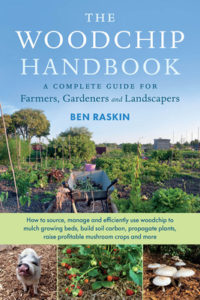A Complete Guide for Farmers, Gardeners and Landscapers
 Written by Ben Raskin
Written by Ben Raskin
Published by Chelsea Green Publishing Company
Reviewed by Dan Jaffe Wilder
The Woodchip Handbook is a small (~200 page) book dedicated to the use of woodchips on the landscape. The book begins with general introductions to concepts before diving into practical topics, including sourcing, managing, and using woodchips for various purposes. Use is broken down by chapter, and the different chapters cover the use of woodchips for plant propagation, soil amendments, mulches, mushroom cultivation, and carbon capture.
Practicality is a key concept that runs throughout the book. Topics are introduced generally and quickly followed with varying versions of how-tos, including case studies, common problems, and solutions. This is clear throughout the book, especially in the section on woodland management, where production and ecological issues come together in a balanced and thoughtful approach.
The book is best suited to farmers and landscapers. While home-scale gardeners will find plenty of interesting and useful information within the book’s pages, many of the details about woodchip management and use are aimed at mid-to large-scale use requiring dedicated space and larger equipment. Gardeners are by no means forgotten, and there is a section on producing woodchips at the garden scale and woodchip sourcing specifically for gardeners.
A comprehensive section on hedgerows and some of the species’ discussions makes it clear the book was written with United Kingdom audiences in mind. Still, good information exists within that can be used by anyone reading, regardless of locality. This useability is clearly purposeful as it’s unlikely any one individual would make use of the entirety of topics covered in the book (ranging from woodchips for animal bedding, to woodchips for plant propagation, to hedgerow management). However, with such a broad range of topics covered, there are almost certainly numerous sections that would be applicable to anyone interacting with the land. The practical approach to the book means that readers can easily go beyond simple information acquisition and will likely finish the book with numerous ideas that can be immediately put into use on their landscape.
About the Reviewer
Photographer and author Dan Jaffe Wilder has over fifteen years’ experience with ecological horticulture. He is a propagator of native species, the photographer and author of Native Plants for New England Gardens and a lecturer on numerous topics including wildlife habitat, sustainable landscape practices, foraging and cultivation of edible species, low-maintenance horticulture and others. He has developed a native plant horticultural database (https://plantfinder.nativeplanttrust.org/Plant-Search) and has years of nursery management experience. Mr. Wilder earned a degree in botany from the University of Maine, Orono, and an advanced certificate in Native Plant Horticulture and Design from Native Plant Trust (formally New England Wild Flower Society). He is the Director of Applied Ecology for the Norcross Wildlife Foundation and is currently building his own home-scale homestead, growing and foraging numerous edible species, preserving and cooking whenever possible, and raising small animals.
***
Each author appearing herein retains original copyright. Right to reproduce or disseminate all material herein, including to Columbia University Library’s CAUSEWAY Project, is otherwise reserved by ELA. Please contact ELA for permission to reprint.
Mention of products is not intended to constitute endorsement. Opinions expressed in this newsletter article do not necessarily represent those of ELA’s directors, staff, or members.

 Written by Ben Raskin
Written by Ben Raskin